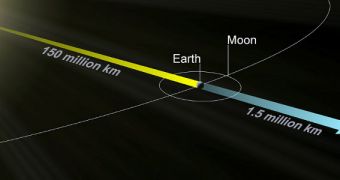Officials with the European Space Agency (ESA) announce that their Gaia spacecraft has finally entered orbit around Earth inside the L2 Lagrangian point, a theoretical location in space where it will always remain in the same relative position with respect to the Earth-Sun-Moon system.
After launching into space aboard a Soyuz-Fregat delivery system, on December 19, 2013, the space telescope spent the following month traveling the 1.5 million kilometers (930,000 miles) to L2, and performing a series of thruster firings to correct its trajectory, Space Daily reports.
The latest short thrust burn occurred on Sunday, January 19, at around 1530 GMT, and followed in the footsteps of another engine burn. The latter occurred last week, and took nearly 2 hours to complete. The maneuvers were supervised by mission controllers at the ESA Space Operations Center (ESOC), in Darmstadt, Germany.
“Lagrange points are special – it's true there's nothing there. They are points where the gravitational forces between two masses, like the Sun and Earth, add up to compensate for the centrifugal force of Earth's motion around the Sun, and they provide uniquely advantageous observation opportunities for studying the Sun or our Galaxy,” says ESOC mission analyst Markus Landgraf.

 14 DAY TRIAL //
14 DAY TRIAL //